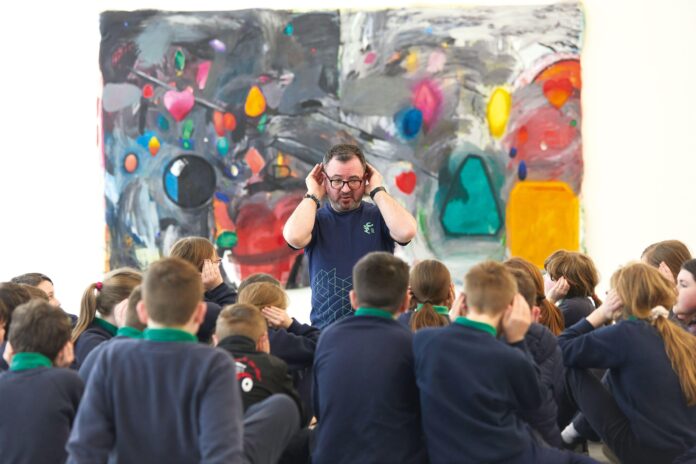• Read about the museums shortlisted for the Art Fund Museum of the Year 2023 here
Despite being around for only 11 years, The MAC Belfast has quickly become an integral part of the Northern Irish city. Not just because it is nestled in the centre of town off a public square, not far from the Belfast School of Art at Ulster University, and has a vibrant programme in its two theatres and three galleries. But also because it has created a whole host of initiatives, workshops and events that have benefited some of the most vulnerable communities living nearby.
“No community is too hard to reach,” says The MAC’s creative director of visual arts, Hugh Mulholland, when I ask him how the museum has had such a far-reaching impact. “But those communities need to want to be involved. It is a bit presumptuous of us to think that we can reach out and offer something that people want.”
While recognising that sectarianism is still prevalent in Northern Ireland – the region at present has no government due to a breakdown in the power-sharing arrangements – The MAC’s engagement with communities has more recently focused on minority groups, specifically the LGBTQ+ community and those seeking asylum, says Mulholland, who cites the recent worrying rise of hate crimes recorded in Northern Ireland.

© Janie Airey, Art Fund 2023
To help broaden the museum’s reach, three years ago it started working with five “associate partners”. These are charities – Participation and the Practice of Rights, Extern, Alliance for Choice, Action Mental Health and the Rainbow Project – that advocate for Belfast’s marginalised communities. When a new exhibition is in the works, the curatorial and engagement teams meet with the partners to discuss co-curational and workshop opportunities.
“If we really want to speak to the communities outside of this building, we need to acknowledge this isn’t my private foundation,” says Mulholland. “We open it up in a way that communities can make demands of us. Through the associate partners, we can address the particular concerns of those individual groups through the work that we are putting on.”
For example, when exhibiting a major body of work by Northern Irish artist Anne Tallentire, whose practice often engages with the use of public space, one associate partner, the charity Participation and the Practice of Rights, became integral to the programme developed around the show. Entitled Politics of Space, the supporting project addressed housing inequality by hosting several children’s workshops, attended by families who were experiencing housing crisis. Participants were invited to look at areas around the city that were vacant to map out their ideal housing solutions. This work was then presented to Belfast City Council.
Through working in this way, The MAC’s team has noticed a shift in the demographic of visitors. Most recently, an exhibition in the Upper Gallery, At the Table, which included work made by participants with a selection of socially engaged artists, saw an increase in visits from families seeking asylum. A Syrian woman who ran a kindergarten in her home country became involved with the museum and now runs a play session every week in the gallery for families seeking asylum who are living in hotel accommodation. “We have found pathways for people to be involved within our organisation,” says Mulholland, “and what I have found is outside of those programmed activities and workshops, people are returning.”
The £120,000 offered to the winner of Art Fund Museum of the Year 2023 would enable The MAC to continue this work, as well as allow Mulholland to support another demographic he views as vulnerable. “One of the other groups that needs exposure and prominence is the artists that live here. The spend per capita in Northern Ireland is much less than on any other part of these islands. It is difficult to choose to be an artist and have a consistent practice anywhere, but it is particularly difficult here. For me, it is about continuing to find creative platforms for artists based here to be able to understand their work within an international context.”
Unsurprisingly, it is those artists that Mulholland thinks of first when he imagines winning the award. His team can see their positive impact in real time, but winning the prize would be an incredible stamp of approval for the artists that engage with The MAC. “It would mean that artists know they are living and working in a place that is contributing to cultural discourse.” For a museum so invested in Belfast, this would be a great reward indeed.

Activists from Participation and the Practice of Rights and the Anaka Women’s Collective at the launch of At the Table © Melissa Gordon
How do you bring your local community into the museum?
Hugh Mulholland: Our recent exhibition At the Table spoke to The MAC’s approach to inclusion – it dealt with some of the most urgent issues in our society and communities making change for themselves. It took American politician Shirley Chisholm’s quote as a stepping-off point: “If they don’t give you a seat at the table, bring a folding chair.” That’s painted on the wall. Artist Khaled Barakeh invited 25 participants from our associate partners to sit opposite 25 decision-makers from local government to engage with issues around asylum. We can’t claim to make societal change, but we can support those groups who can inform those in power by providing a platform for their activism.

























